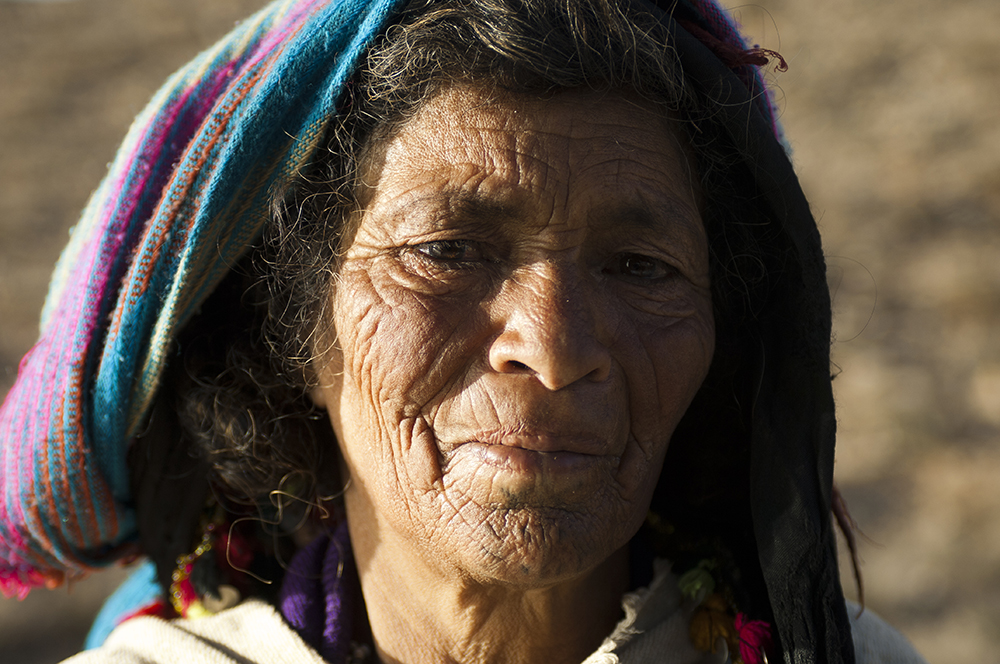Mbarka bint Hamou al-Bheisheh, she became famous as a veteran resistance poet, in the pre- and post-protection period. She lived in the Beni Mellal region. And as stated in many novels, she is the author of the poem “The Brave,” which is considered to be the epitome of the Bedouin folk lyric heritage. She repeated her words on various occasions, and in various tribes, especially Tadla, Bani Mellal, Rahmani, Saraghna, Za’er, and others. I did not find anything indicating the date of her birth, the date of her death and the conditions of her life, except for what was stated by an article published on an old website belonging to the delegation of the Ministry of Culture and Communication at the time. (Tadla-Azilal), includes some valuable information in what we are about.
According to the oral narration of Ahmad Shuaila from Beni Malal, on the authority of his grandmother Zahra Haddo Ibn Al-Soghair, she said: “Nairiyah was at the beginning of the foreign intervention, riding a horse, and carrying a vessel full of henna water. She followed the resistance fighters, urging them to confront the colonial French army, and those who were late to the first row, she would spray henna water on him to let the tribe know that he had abandoned his position. Therefore the knights could not leave their positions. And they preferred to die in the fighting, to return to their families dyed with henna water.
This woman was called Nairiya, in reference to the naira, which in common people means that wooden beam that pulls the strings. The word appeared in an ancient Arabic proverb that says: “It is not a stamen, nor flesh, nor yard.” That is, that person is not important or useless. It was mentioned in the Modern Arabic Lexicon p .: 1232, “Naira is a genus of forest trees of the family of virgins. Its wood is solid, industrial ». It seems that she was called this title due to her composure and toughness in the face of the events that took place in the various regions of the Tadla Plain and the Middle Atlas during the French encroachment at the beginning of the last century.
Some History:France’s colonial policy after subjugating the regions of the east, north and center to the borders of Chaouia, at this time aimed to penetrate towards the south, in order to reach the rugged natural borders (the High Atlas and the Middle Atlas) to secure its presence in the aforementioned regions. This colonial orientation expresses what General Leoti wrote in a letter he had sent from Paris to Colonel Mangan in Taza on April 10, 1914. In which he says: “… the observers will remind us once again of their aphorism, that any nation is civilized in order to preserve borders with barbaric peoples It must expand as much as possible, until it finds rugged natural barriers, such as seas or wastes, or the lands of another civilized nation. They will also bring to our minds once again the saying of BUGEAUD regarding Algerian Kabyles: You cannot keep the plain unless you preserve the mountain ».
However, this penetration towards the south was not easy for the invading forces, as the tribes bordering the Great Atlas and the Atlas interfered with it, especially the Rahamneh, Masfuh, Damanat, Saraghna, Bani Mellal, Bani Musa, Bani Omair, Tadla and Sama’la tribes. As well as the tribes of the Sahara, Souss and Xian in famous days and sites.
These facts and events awakened the political feeling of the common people, and pushed them to assert their national identity, whether through armed resistance or through creative resistance, the latter, which became the appropriate artistic and cultural response to the material violence of French colonialism, through the practice of symbolic violence that finds its fertile substance In the heritage of the oppressed people, it produced a new purpose of singing in the art of Aita, erasing its images and expressions from the Bedouin cultural stock, and expressing its popular position rejecting the domination and power of the occupier by invigorating the values of heroism, magnanimity and redemption, in an epic atmosphere, reminding glories, places and names. The poem was “The Brave” or “Nyeriya”. The best expression of this new popular Bedouin singing, which gained its identity and was independent of the traditional lyrical purposes of Aita that prevailed in the pre-protection period. The subjects of the folk groups’ singing practicing the art of Eita were related to the life of the Bedouin Moroccan and his feelings of love for women, fondness for chivalry, and love for nature. It is the characteristic expressed by many of the poems and songs, including the famous “boys”. As one of her pieces says:
Three in the world are equal, including the inclination of *** Atai shrieb with mawn, baby breasts, and horseback riding.
But this divine characteristic, playful, which Marquis de Segonzac also expressed in Salaf, saying: “The areas of happiness that they know – Moroccans – are those that they live on the back of a horse, or in the hands of a woman, the joys that are fleeting and momentary, they do not show any tenderness or tenderness. . Chivalry lasts seven minutes, sex seven seconds, and unhappiness the rest of life. ” It will take another, firmer and more serious approach, when the foreign incursion began threatening the Moroccan entity in its foundations, so the woman transformed from a body calling for seduction, to a blast that loudly declares the tragedy during the years of political drought. The knight and the mare have turned from furniture to watch during the seasons and holidays to a symbol of magnanimity, strength and glory … Therefore, many researchers consider that the art of Aita is equestrianism in itself, as it is based on the elements of women, the horse, and the knight. It is based on the values of courage and chivalry, and the virtues of Moroccan origin and rage mixed with Arabic and Berber. Therefore, the art of Aita did not come from a historical void, but rather is the production of the collective history of tribes that have remained and still constitute a single nation called Morocco, although its chanting language appears to be marked by tribal nervousness (Hasba Mersawi, Al-Hawzi, Al-Zaari, Al-Jabali …)From this point of view, although this poem is attributed to the Baihechian blessing called Niriya, reality requires that it be considered a collective literary production by virtue of its affiliation with popular oral literature, and we cannot attribute it to a specific person in itself. Societies, and this explains the multiplicity of the narratives of this poem, or let’s say today’s version of it is VERSIONS. There is the Malian version, there is the Za’ari version, and there is the Rahmani version, which according to some compassionate narrators, has spread in this region through Za’er. And they used to express that by saying, “Al-Hawzi is of a thorny origin” … But despite this multiplicity, this poem has kept its structural system and general coordination. Each tribe has added to it what suits its cultural peculiarities and its own history, according to circumstances and conditions. In order to make room for comparison, we will try to review the Niriya in its Malayal version, before we review it in its Rahmani version.
Mellali version:
In the name of God, bash our souls
Mohamed Boukhar

